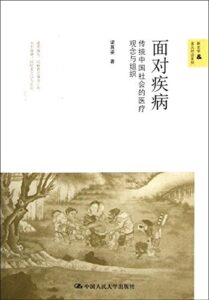
Leung Ki-che 梁其姿
Beijing: China Renmin University Press, 2012
Reviewed by Ge Yun (PhD Candidate, Department of Sociology, National University of Singapore)
This book is not an entirely new work. Rather, the book “Facing Illness” retraces the intellectual path taken by the author, collecting some of her important contributions. Professor Leung Ki-che has been intensively engaged in working on China’s medical history for the past twenty years. The historical tracking of smallpox and leprosy (see chapter 3, 11-13) reflects her insights into the changing views on illness in Chinese society. Influenced by research paradigms of medical history in the West, Leung pays less attention to the charismatic role of doctors and of medical knowledge. Instead, she carefully portrays the various facets of the medical system of imperial China. Familiarity with the protagonists, including patients, businessmen, missionaries and female medical practitioners (see chapter 4 and 9), as well as with the organizations, including public and private medical institutions (see chapter 6 and 7), greatly enriches our understanding of how illness was constructed and transformed. Therefore, although the book is framed in a historical perspective, it goes beyond discussions in the discipline. Many chapters, such as chapter 5, entitled “Medical History and the Issue of China’s ‘Modernity’” (医疗史与中国“现代性”问题), address profound socio-political and institutional issues. There is a clear effort to connect medical history to China’s social and cultural environment.
As the author herself points out in the preface, the book calls for a field of medical history studies in China. It is worth noting that at the outset of her book, the author warns herself and the readers: when adopting western paradigms to research Chinese medicine history, one should be critical. Medical history is not regarded as a mainstream topic in the history discipline in China. Research and teaching of medical history are often conducted in universities and research institutions specializing on Chinese medicine. This institutional arrangement benefits the field by attracting a group of researchers, who understand the substance of the knowledge. But it also hinders and obstructs the integration of medical history into broader socio-cultural histories of China. In her book, Leung calls for strengthening the interdisciplinary collaboration between history and Chinese medicine. Only in this way can the research of Chinese medical history avoid the risk of isolation and re-appropriation.
